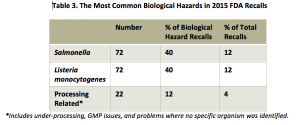There were 357 recalls caused by chemical hazards. Although chemical hazards include a wide range of problems, three-quarters of these recalls were caused by undeclared allergens (Table 4). In 2015, undeclared allergens caused 46 percent of all FDA food recalls, which is similar to past years when approximately half of all food recalls were linked to food allergens. Approximately 60 percent of allergen recalls were Class I and about 10 percent were Class III. This year, a number of recalls early in the year were caused by finding peanut protein in imported cumin. About half of the FDA cumin/peanut recalls were Class I, one was Class III, and the rest were Class II. Although the root cause of the problem was never discovered, or at least never made public, these recalls serve as a reminder of the potential impact of economic adulteration on high value imported products such as spices.
The year 2015 was also busy for the USDA Food Safety and Inspection Service (FSIS). In 2015 there were 150 FSIS recalls, which is a substantial increase from 94 the
year before. As with FDA, a substantial proportion of these recalls were Class II and more than half the recalls were caused by chemical hazards. Undeclared allergens caused 58 recalls, 39 percent of the total for the year. Approximately 20 percent of the FSIS recalls were caused by food that was “produced without the benefit of inspection” or “imported without the benefit of inspection,” which emphasizes the different regulatory authorities for FDA and USDA. Like FDA, there were multiple recalls linked to the peanut in cumin problem early in the year. Unlike FDA, all but one of these recalls were Class I.
The Canadian Food Inspection Agency (CFIA) makes information available on foods recalled in Canada. Despite the different government and regulatory structure, the overall recall pattern in 2015 was very similar to that seen in the U.S. (Table 6). Also, like in the U.S., about half the recalls were caused by undeclared allergens (47 percent in Canada), including several related to cumin.
The fact that on average for the three agencies, about 50 percent of recalls were Class II points out how important recall information is for PC and HACCP assessments. In the U.S., information from sources such as the CDC Foodborne Outbreak Online Database and the FDA Reportable Food Registry Annual Report is often considered to be an accurate and complete description of foodborne public health risks. However, both of these sources only include information on situations that did or would lead to Class I recalls. This means that any problem that would give rise to a Class II recall, or that involves a hazard not tracked by the public health reporting system, is not represented in either data set although there may be a public health risk. In addition, the publically available data in both of these resources is historical rather than “real time.” In contrast, FDA, FSIS, and CFIA all make recall data available on a daily or weekly basis. This means that recall data are more up-to-date and can be used effectively to assess emerging or rapidly changing situations.
Many companies monitor recall announcements as a current awareness tool should one of their suppliers, customers, or competitors be involved in a recall. However, it is clear that a deeper look at recall information provides important insights that can be used to help identify “known or reasonably foreseeable” hazards and to determine which of these require preventive controls.




Leave a Reply